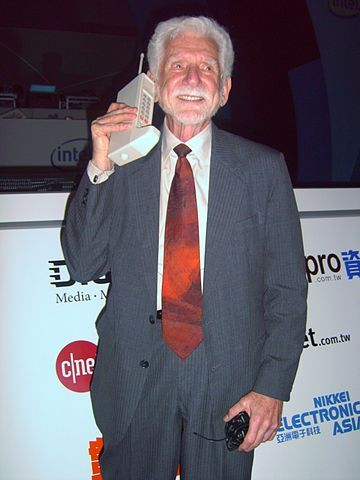Mobile phone pioneer wins 2013 Marconi prize
Wireless visionary Martin Cooper reshaped the concept of mobile communications by leading the Motorola team that developed the handheld mobile phone.
Forty years to the day after he helped launch the age of portable mobile telecommunications, the Marconi Society has announced that Martin Cooper is the recipient of the 2013 Marconi Prize, considered the pinnacle honour in the field of communication and information science.
Cooper, a wireless visionary and serial entrepreneur, is credited with developing and popularising the concept of the handheld mobile phone. He led the talented team that put Motorola at the forefront of a burgeoning new industry. In the process, he helped reshape and point the global telecommunications industry in a new direction.
The Marconi Prize, which he will receive at a ceremony this fall in Bologna, Italy, is given each year to one or more scientists and engineers who - like radio inventor Guglielmo Marconi - achieve advances in communications and information technology for the social, economic and cultural development of all humanity.
Following in famous footsteps
Winners have included scientists whose breakthrough innovations underlie every aspect of modern communications and have contributed to many other fields of technology. They include ‘fathers of the internet’ Paul Baran, Vint Cerf, Robert Kahn, Leonard Kleinrock, Sir Tim Berners-Lee and Bob Metcalfe; encryption pioneers Whit Diffie, Martin Hellman and Ron Rivest; internet search engine pioneers Larry Page and Sergey Brin; DSL modem inventor John Cioffi; and breakthrough fibre-optics scientists such as Nobel Laureate Sir Charles Kao, Sir David Payne, Bob Tkach and Andrew Chraplyvy.
Cooper follows wireless communication trailblazers Irwin Mark Jacobs (co-founder of Qualcomm) and Henry Samueli (Broadcom co-founder) who received the prize in 2011 and 2012, respectively, as well as his mentor, former Motorola CEO Robert W Galvin, who received a Marconi Society Lifetime Achievement Award in 2011.
Cooper’s selection for the Marconi Prize is extraordinarily apt, according to Marconi Chairman Sir David N Payne, the 2009 prizewinner. “Like Marconi himself, Marty had to overcome innumerable challenges,” says Dr Payne. “In the ’60s and ’70s when he first set out to create a truly mobile wireless phone, there weren’t even any cordless phones on the market. Low drain digital circuits were just being developed. Even most of the industry leaders didn’t see much of a market for a personal, portable mobile phone. But Marty’s visionary pursuit of portable wireless communication changed the course of wireless communications.”
“What makes Marty unique is his rare combination of technical knowledge, engineering skill and marketing vision,” said Henry Samueli, last year’s Marconi Prize recipient. “His revolutionary invention of the mobile phone created a remarkable industry which today impacts virtually every person on the planet. It is very fitting that he is receiving the Marconi Prize.”

Born to be an engineer
Cooper says he was born to be an engineer. “From my earliest remembrances I had to know how things worked. I never had any doubt my career would be about technology,” he says. After graduating from the Illinois Institute of Technology (IIT) in 1950, he served in the US Navy as a submarine officer during the Korean War. When he returned, he earned his master’s degree from IIT in electrical engineering. He later taught at IIT and now serves as a life trustee of the university.
His first job was at Teletype Corporation. He left to join Motorola in 1954, at a time when Galvin, son of the company founder, was transforming Motorola from a car radio manufacturer into a global technology leader. Starting as a senior development engineer in the mobile equipment group, he eventually grew to become a corporate vice president and founded the division that became Motorola Mobility, now owned by Google. Cooper introduced products that were precursors to cellular phones - including the first city-wide radio pagers in 1970 and the first cellular-like portable handheld police radio systems in 1967.
“Motorola was one of the luckiest things that ever happened to me,” Cooper says. “If you wanted to change society it was the place to be. In 1965 I was given a new assignment to head the Portable Products Group. We had one overriding belief: that people are inherently mobile, and that their mobile devices could not be too small or too light. We created the technologies that optimised size and weight.”
A dazzling demonstration
At the time, AT&T, which invented the concept of cellular technology, was investing heavily in their own vision of the future of mobile communications - car phones - and was already lobbying the Federal Communications Commission (FCC) for exclusive spectrum rights. In 1972 the FCC announced it was about to make a decision and it seemed likely AT&T would be granted a monopoly.
All that changed on 3 April 1973 when, standing on a street corner in New York City, Cooper demonstrated Motorola’s handset prototype to a reporter by making the first public phone call on the handheld cellular phone. His goal was to create public excitement about a revolutionary new concept in telecommunications: truly portable mobile phones that people could carry around and use to make calls anytime, any place.
“I decided the only way to make an impression was to do a dazzling demonstration,” says Cooper. “What better way than this? My extraordinary team built the handset and a complete cellular system, just for the demonstration, and we took it to New York and to Washington to persuade our government that the time was ripe for true ‘personal communications’.” The publicity campaign worked beyond anyone’s expectations.
Impressive engineering feat
A decade of challenges lay ahead. “It took years for the technology to evolve,” says Cooper. “We were using frequency bands never used before; we were trying to develop large-scale integrated circuits with low drain; and even the antenna had to be engineered. You can’t go from the lab to a commercial product overnight.”
He named the original handset the DynaTAC (DYNamic Adaptive Total Area Coverage). It was gigantic by modern standards, weighing in at just over one kilogram and measuring 25 cm long. People called it “the brick” or “the shoe”. Improved technology would soon shrink the massive battery needed to power the original phone and multiply battery life, but the original was still an impressive engineering feat.

More than the handset technology needed development. “Bell Labs and Motorola had to develop the equipment that made cellular systems more efficient than previous approaches. Plus, the FCC was tasked with the arduous and painfully slow challenge of selecting the competing cellular carriers,” Cooper says.
Once again, it was Motorola that tipped the balance. In 1980 Galvin was visiting Vice President George HW Bush and showed him Motorola’s handset model, mentioning the FCC’s delays. Bush told him to show the phone to President Reagan, who was enchanted. “That seemed to break the logjam, and by 1983 we had service,” says Cooper.
Between 1973 and 1983 Motorola poured more than $100 million into development without getting a nickel of revenue. “It takes an enlightened management to do that,” Cooper says.
Revolutionising our world
Currently, Cooper is co-founder and Chairman of Dyna LLC, in Del Mar, California, one of the many successful entrepreneurial ventures he helped create in the 30 years since leaving Motorola. In addition to writing and lecturing around the world, his many board and committee commitments include the US Department of Commerce Spectrum Advisory Committee and the Federal Communication Commission’s (FCC) Technological Advisory Council. Among his many awards and honours was his inaugural induction into the WHF Wireless Hall of Fame and his receipt of the IEEE Centennial Medal. Cooper also was inducted into the National Academy of Engineering and was awarded the Prince of Asturias Prize for Science and Technology in 2010.
He is proudest of his contributions to portable wireless communications, however. “The biggest problem our world faces is poverty,” he says. “The answer isn’t redistributing wealth - that would simply make most people poorer. The answer is improving productivity - and wireless has brought about massive improvements in productivity. From a village in India where a woman entrepreneur can rent out her cell phone to farmers so they can find the best price for their crops, to the ability to monitor individuals’ health status in real time, mobile communication is revolutionising our world - and we are only just beginning.”
“Today, what Marty foresaw seems pretty elementary,” says Vint Cerf, vice chairman of the Marconi Society and himself a Marconi Prize winner. “But the idea of making telecommunications ‘person-centric’ instead of tied to a particular place - a car, home or telephone booth - caused a tectonic shift in the industry.”
Cooper will receive the $100,000 Marconi Prize at an awards dinner on 1 October 2013 in Bologna. He also will deliver the keynote address for a three-day conference preceding the awards gala, jointly sponsored by the Marconi Institute for Creativity and the Marconi Society. Information about the conference, which is open to the general public, will be available soon at http://mic.fgm.it/.
The Marconi Society was established in 1974 through an endowment set up by Gioia Marconi Braga, daughter of Guglielmo Marconi, the Nobel laureate who invented radio (wireless telegraphy). It is best known for the Marconi Prize, awarded annually to outstanding individuals whose scope of work and influence emulate the principle of “creativity in service to humanity” that inspired Marconi. Through symposia, conferences, forums and publications, the Marconi Society promotes awareness of major innovations in communication theory, technology and applications with particular attention to understanding how they change and benefit society.
2025–26 Thought Leaders: Tim Karamitos
Tim Karamitos from Ericsson discusses the connectivity requirements of emergency services and...
2025–26 Thought Leaders: Ruth Tovo
Comms Connect panellist Ruth Tovo, from the South Australian SES, discusses the technical...
ARCIA update: celebrating excellence in our industry
The ARCIA Annual Gala Dinner and Excellence Awards took place during the same week as Comms...






